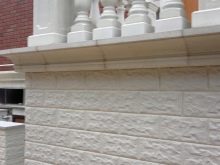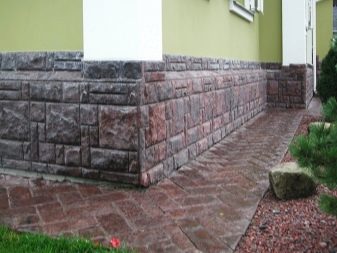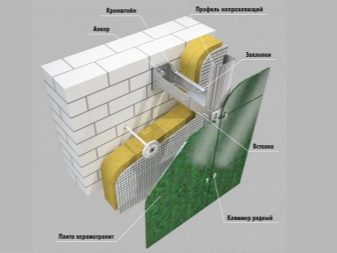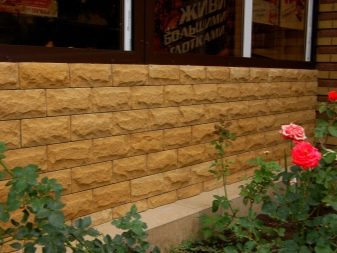Basement tiles: the subtleties of the selection of finishing materials

Today the construction market abounds in a variety of facade finishing tiles. However, the choice should be made, guided not so much by personal preferences as by the purpose of the material. So, for the tile for the basement, high requirements are imposed on strength, wear resistance, weather resistance.



Peculiarities
The plinth is the lower part of the facade, usually slightly protruding forward. This is a kind of "layer" between the foundation and the main part of the building.
The plinth is more exposed to mechanical and shock loads than other parts of the facade. In winter, it is not only exposed to low temperatures, but also freezes into the ground.
At the moment of snow melting, as well as during precipitation, the basement is actively affected by moisture, and in most cases, particles of road reagents and other aggressive components are present in the melt water.

All this leads to increased requirements for strength, frost resistance, chemical inertness and moisture resistance of the finishing material for the basement part. And since it is inextricably linked with the facade, it is important that the material is characterized by visual appeal.
These requirements are met by basement tiles, which can have a different design, imitate a particular surface and be made from different compositions. The only thing that remains unchanged is the high density of the basement tiles, the greater thickness compared to the facade counterparts and, accordingly, improved strength indicators.


Together with an increase in the thickness of the material, its heat and sound insulation characteristics increase.
The obvious advantages of the base / plinth tiles are:
- reliable protection of the building from moisture penetration;
- increasing the thermal efficiency of the building;
- most modern materials are non-flammable or have a low flammability class;
- increased strength characteristics, wear resistance;

- weather resistance;
- ease of installation - the tile has convenient dimensions (its height usually corresponds to the height of the foundation);
- ease of maintenance - many surfaces have self-cleaning surfaces, most of them are easy to clean using a stiff brush and water;
- long service life, averaging 30-50 years.


The disadvantage is the greater weight of the material, which requires additional strengthening of the foundation. However, you can always find an easier option and, perhaps, resort to reinforcing the base.
For example, if the foundation is not strong enough to install clinker tiles, it may be enough to mount a lighter basement metal siding.
If necessary, you can select panels with imitation of the same clinker.


Views
Plinth tiles can be made of various materials. Let's consider the most common types of tiles.
Clinker
This facade tile appeared as an alternative to the more expensive and heavy facing clinker bricks. It is not surprising that it imitates brickwork, although there are also options for a stone.
Clinker tiles are based on clay, which is subjected to high-temperature firing.As a result, a super-strong material is obtained, which is characterized by low moisture absorption, heat resistance, frost resistance. In terms of its reliability, it is comparable to granite slabs.


The material itself does not have high thermal insulation qualities, therefore it requires the use of insulation. But today you can also find a thermopile - an improved sample based on clinker, equipped with a layer of polyurethane or mineral wool insulation. In addition to this two-layer version of the hot plate, there are three- and four-layer ones, which are equipped with additional stiffening plates and fire-resistant inserts. Clinker tiles are distinguished by their high cost, which, however, pays off for a long period of operation - 50 years or more.

Polymer sand
Having sand in its composition, the tile has lightness, good vapor permeability. The small weight of the product makes it possible to install it even on unreinforced bases, as well as supporting structures with a low margin of safety. The presence of polymer resins ensures the strength and moisture resistance of the product, its ability to maintain its integrity and geometry when exposed to high and low temperatures. High plasticity protects tiles from chips and cracks. It is installed both dry and wet.


Hyperpressed
This tile is also characterized by low weight and strength, has increased moisture resistance, as well as an attractive appearance. Externally, it is very similar to clinker tiles.


Stone
Such tiles are made using natural or artificial stone. Natural stone, however, is less and less used for decoration. Despite the large margin of safety, it is too heavy, difficult to handle and maintain, it can have a radiation background, and, finally, it has a high cost.
But if you do decide to use natural stone, choose a flagstone finish. This is a group of stones in the form of irregular plates, the thickness of which rarely exceeds 50 mm.

Worthy analogs of the material are porcelain stoneware, bassoon, which are varieties of artificial stone. The main components of such materials are granite and other natural stones ground into crumbs, as well as polymer resins. The result is plates that are not inferior in reliability to their natural counterparts, but lighter, more moisture-resistant and have a lower cost.
It is fair to say that the weight of porcelain stoneware still remains considerable, so it is used only on solid foundations. Thanks to modern technologies, artificial stone tiles imitate any natural surfaces - granite, slate, processed and rough stone surfaces, and so on.

Resin board
This facing tile is flexible, elastic, which makes it possible to use it for facing semicircular and round base / plinth elements. Outwardly, they imitate brickwork or "torn" stone.
The decorative tiles can be cut with construction scissors, which facilitates the installation process. Installation is carried out with a wet method on special glue, no grouting is required, therefore an impressive monolithic surface is formed. A layer of insulation can be laid under the product. There may be a concrete or plastered surface under the tiles.


Ceramic
Ceramic tiles are environmentally friendly and moisture resistant. In terms of its reliability, it is slightly inferior to one of the most durable clinker tiles. However, unlike the latter, ceramic tiles have lower thermal conductivity.
Externally imitates stone surfaces, fixed only on the crate.


Siding plinth panels
The material can be based on PVC (rarely, it is better to refuse to purchase), a metal or fiber-cement frame. Fiber cement slabs are stronger, more durable, but have more weight and higher cost.Metal siding products, however, also withstand increased loads and have anti-corrosion protection.


Styling tips
It is possible to preserve and show the best technical characteristics of the basement tiles only if the installation technology is observed.
Wet way
This process includes several main stages.
Preparing the wall
The surface is leveled, the old coating is removed, and the wall is treated with 2-3 layers of primer. Then a layer of heat and waterproofing materials is laid, on top of them is a metal reinforcing mesh.

Wall marking, preparation of materials
In accordance with the dimensions of the tiles, the basement is marked. Do not neglect this stage, because this is the only way to achieve a flawless appearance of the base.
After the marking is completed and checked, they begin to prepare the adhesive composition. It is recommended to use a special frost-resistant adhesive for basement tiles. It possesses good adhesion, withstands 150-300 freezing cycles and ensures reliable fixation of the tiles.
Preference should be given to formulations from well-known manufacturers; before buying, make sure that the storage conditions are properly observed by the seller.
Remember that even the highest quality and most expensive tiles will not be able to protect the base if you choose glue of dubious quality. The material will just start to move away from the wall.

Fixing the tiles
With the wet installation method, the glue is applied to the wall (the size of the glue spot should be slightly larger than the tile to be glued). Apply the same or slightly less adhesive layer with a notched trowel to the back of the tile. After which it is pressed against the surface and held for several seconds.
The tiles are laid with gaps, the uniformity of which is achieved through the use of beacons or a steel bar with a round cross-section of a suitable diameter. Usually the inter-suture space is 12-14 mm.


Grout
After the tiles have dried, the space between the joints is treated with a trowel compound.
In this way, mainly clinker tiles are laid.

Hinged system
Most of the modern tile materials are attached to the lathing, which is erected on the surface of the walls of the building. The frame is constructed from metal profiles or wooden bars. Its fixation to the walls is carried out by means of clamps.
After mounting the frame, the facade slabs are attached to bolts, self-tapping screws or special fasteners (for example, movable skids). Decorating corners and other architectural elements, as well as window and door slopes, allows the use of additional elements.


The advantage of the hinged system is that there is no additional load on the foundation, which cannot be said when fixing the slabs with a wet method. It is possible to fix the panels regardless of the characteristics and condition of the wall covering of the building, as well as hide minor defects and differences in the height of the walls.
Curtain systems usually involve maintaining a small air gap of up to 25-35 mm between the facade and the wall. The system is called ventilated and improves the thermal performance of the building.
Often, insulation is laid between the wall and the crate, which also provides an increase in the thermal insulation characteristics of the structure.


When constructing the lathing, it is important that the metal profiles are made of moisture-resistant materials (aluminum, stainless steel) or coated with anti-corrosion powders.
Wooden lathing is used less often due to lower strength indicators, it is suitable for cladding a basement of a small area and does not provide for the use of heavy facade slabs. In addition, wooden elements must be carefully treated with fire retardants and compounds to increase moisture resistance.
First, the basement tiles are installed and only after that the facade cladding.This is due to the need to organize an ebb, which protects the protruding part of the base from moisture, and its lining.


Dimensions (edit)
There is no single standard approving the size of basement materials. Plates of different types and produced under different brands differ in their dimensions. Unity is seen when it comes to coating thickness.
The thickness of the basement tile is usually 1.5-2 times the thickness of a similar facade material. Tiles of this type must have a thickness of at least 17-20 mm.


In general, there are 3 main dimensional types of basement tiles:
- large-sized (their length can reach 200-250 mm);
- medium-sized (length ranges from 80-90 mm to 10-120 mm);
- small (usually correspond to the size of facing bricks or have slightly larger dimensions).
This division is very arbitrary, usually for each type of tiles its own size ranges are provided.

How to choose?
Before purchasing a tile, you should decide how the material will be laid, and clarify the bearing capacity of the foundation. Unreinforced slabs will definitely not be able to withstand heavy slabs based on stone or cement. Ideally, the option of facing the facade and basement should be decided at the stage of developing the construction plan.
When you come to the store, make sure that you are evaluating or offering you material designed specifically for outdoor use. As a rule, it has a special marking "snowflake", which indicates the frost resistance of the product.


Ask the seller to present certificates and other documents confirming the originality of the product. Of course, it is better to buy products from well-known manufacturers. The leading positions in the market are occupied by German and Polish companies. The use of tiles should not be limited to less than 20-25 years of operation.
If you need to glue the tiles, and then rub the seams, choose frost-resistant compounds of the same brand.


If you cannot decide on the shade of the tiles, choose those that are a tone darker than the main finish. This option is usually a win-win. Preference should be given to materials, the shade of which occurs during the firing process without the addition of pigments (if we are talking about clay-based tiles).
Tiles with painted surfaces must be protected with a reliable transparent polymer layer (as an option - have a ceramic coating). Only in this case can we talk about the preservation of the color of the material during the entire service life of the basement facade.



Beautiful examples
Houses, the plinths of which are finished with natural or artificial stone, always look solid and respectable. The rest of the façade is usually clad with brick, plaster or stone (or materials that mimic these surfaces). In this case, it is important that the stones in the basement are larger in comparison with the elements of the facade decoration.


Sometimes materials of the same structure, but different in color, are used for finishing the basement and the facade. The color scheme can be either close or contrasting.


Smooth brick on the facade is harmoniously combined with similar material on the basement part. True, the brick here can have corrugation. In other words, the facade should become a calmer backdrop for the textured, attention-grabbing basement tiles.


See below for more details.













The comment was sent successfully.